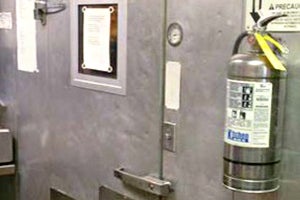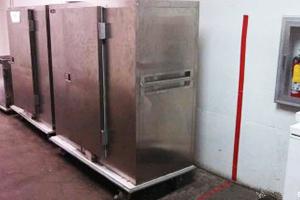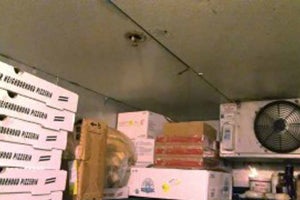Protecting perishables ― Don't let spoilage ruin your business
Food service establishments, such as supermarkets, restaurants, convenience stores, fast food joints, and drug stores always play an important role in the community. Following a natural or manmade disaster, they may become even more important, by serving as lifelines providing food and medicine to people who have lost power — or even their homes. Therefore, it is critical that these establishments take precautions to protect perishable foods and medications from spoilage. Proper planning not only will reduce property and economic losses for food service businesses, but also will help to assure that refrigerated/frozen food and vital medicines are available when they are most needed in the community.
Other facilities that store refrigerated or frozen perishable goods include habitational facilities such as nursing homes and assisted living facilities, as well as schools. Proper spoilage precautions of perishables are extremely important for these types of facilities, in particular, because they often serve vulnerable residents with mobility issues. Hospitals, food processing, cold storage facilities, and large industrial plants also must plan to safeguard their perishables, but generally rely on more complex systems that are beyond the scope of this article.
In addition, spoilage prevention plans should be part of a broader business continuity plan designed to make sure a business can resume operations quickly, even if the premises are damaged. The Insurance Institute for Business & Home Safety’s OFB-EZ (Open For Business-EZ) is a free, downloadable toolkit that takes small business owners through the essential steps they need to keep functioning in the event of a major disaster or smaller disruption. The toolkit is available at www.disastersafety.
Spoilage hazards
Common causes of spoilage are:
- Utility service interruption
- Equipment breakdown
- Accidental discharge of sprinkler heads
- Breach of the building envelope from flood or wind
Utility service interruption
Utility service interruption can be greatly reduced or completely mitigated by putting in place a pre-emergency plan that includes reliable back-up power and/or alternative refrigeration solutions.
Back-up power considerations:
- Determine the most likely sources of power outages.
- Estimate the frequency and duration of potential power losses.
- Estimate the worst case scenario for power loss duration.
- Consider investing in back-up power through a portable or permanent generator (can be purchased or leased).
- For proper understanding of load demands on a generator, determine what refrigeration, freezer, and any other related electrical equipment must remain operable when normal power is interrupted. Contact a certified electrician to conduct an electrical load analysis of the equipment to determine the power consumption.
- Conduct a cost-benefit analysis to determine what type of back-up would provide sufficient power.
- For more information on generator selection options, usage, maintenance, testing, and safety concerns, see IBHS’s Commercial Generators — Keeping Your Business Running.
Alternative refrigeration options:
- If 100% power cannot be supplied to all refrigerated spaces, create a plan to move product prior to a storm or immediately after.
- Provide alternative storage locations through mutual agreements with sister locations or businesses outside of the disaster areas and/or through the use of refrigerated trucks.
- Investigate mutual agreements with sister locations or other businesses to have substitute products available in case your inventory does spoil, so that you can maintain operations and your customer base.
Equipment breakdown
Equipment breakdown loss can be reduced or mitigated through preventive maintenance and pre-emergency plans.
Consider the following measures:
- Regularly conduct preventive maintenance of refrigeration equipment including fans, blowers, motors and related parts in accordance with the manufacturer’s specifications.
- Maintain an inventory of spare parts for critical equipment, and supplies for refrigeration systems including fans, blowers, and motors.
- Purchase and maintain temperature alarms for freezers, refrigerators, and walk-in coolers.
- If possible, have spare in-place refrigeration/freezer capacity, or portable coolers and freezers. They also may be useful to store product that has a longer shelf life and does not require immediate back-up power.
Accidental discharge of sprinkler heads
Accidental discharge of sprinkler heads in walk-in freezers and coolers can greatly be reduced by:
- Creating employee awareness by helping them identify the sprinkler head(s) as shown in the photo below and alerting them of the importance of avoiding contact with them and not breaking them. Portable coolers can be used to store items if there is an equipment breakdown of the permanent storage, while workers address the problem.
- For walk-in coolers or freezers that are protected by fire protection sprinkler heads, have a pre-emergency plan that addresses an accidental sprinkler head discharge of water from a broken head and how to shut off the water by using the appropriate sprinkler control valve.
Building envelope protection
Building envelope protection should be part of your business’s overall disaster mitigation planning and include an understanding of the physical hazards that may affect your location. Considerations to strengthen your building to prevent or reduce damage include:
- If your business is located in a hurricane-prone region, ensure that your roof and windows are properly secured and protected.
- Determine if your business is located in a storm surge or a flood zone. See IBHS’s Evaluating Flood Risk at www.disastersafety. org/flood/evaluating-flood-risk/. If exposed to flood waters, ensure preventive measures are taken to prevent flood waters from entering the building and/or damaging vital electrical service equipment. See IBHS’s Prepare and Protect Your Business from Floods at www.disastersafety.org/disastersafety/prepare-and-protect-your-businessfrom-floods/.
- If your business is exposed to freezing temperatures and snow, learn how to prevent roof damage in IBHS’s Reducing Roof Risks on Businesses at www.disastersafety.org/ freezing_weather/reducing-roof-risks/ and Preventing Ice Dams on Businesses at www.disastersafety.org/freezing_weather/ preventing-ice-dams-on-businesses/.
Emergency planning, response, and recovery
Emergency pre-planning will reduce the potential for loss of property and business operations. It will also provide peace of mind while reducing stress on employees and the local community before and during a catastrophe.
An emergency plan for perishables should:
- Recognize that different types of foods and medicines have varying shelf lives. In order to properly protect your commodities, determine what the specific perishable hold times are for products and add in a safety zone.
- Maintain an updated emergency plan that includes personnel and alternates with designated responsibilities for protecting perishables during all shifts, including off hours, nights, and weekends.
- Address recovery and salvage procedures and opportunities such as selling produce to zoos or ice cream to pig farms.
Proper insurance coverage
Contact your insurance professional to determine if your insurance coverage includes perishable goods and equipment breakdown. Often they may be combined into one program.
Staying Open for Business®
While it’s critical to protect your perishables, you also should make sure that your business is operational following a disaster that affects your location. With a business continuity plan such as OFB-EZ in place, you will have a better chance of remaining competitive and minimizing the loss of revenue and customers, particularly at a time when the community may need your goods and services more than ever. This is also a good way to boost public confidence in your enterprise, as current and future customers remember who was open and providing perishable food and medicine during a traumatic time.
Learn more about Hanover Risk Solutions at hanoverrisksolutions.com.
171-10004 (4/16) LC 2016-090





